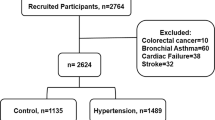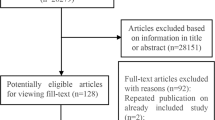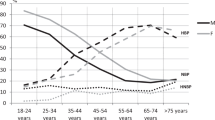Abstract
Few previous studies in Western populations have reported an association between C-reactive protein (CRP) and prehypertension. However, no previous study has examined this association in Asians. We examined individuals who were free of hypertension from two independent population-based studies in Singapore: the Singapore Prospective Study Programme (SP2, n=2843 Chinese, Malay and Indians aged ⩾24 years) and the Singapore Malay Eye Study (SiMES, n=957 Malays, aged 40–80 years). Prehypertension was defined as systolic blood pressure (BP) 120–139 mm Hg or diastolic BP 80–89 mm Hg. CRP was analyzed as categories (<1, 1–3, >3 mg l−1). The prevalence of prehypertension increased with increasing categories of CRP in both cohorts (P for trend <0.05 in both cohorts). After adjusting for potential confounders including body mass index (BMI), smoking and diabetes, persons with higher levels of CRP were more likely to have prehypertension in both SP2 (compared with CRP <1 mg l−1, odds ratio (OR) 1.23, 95% confidence interval (CI) 1.03–1.48 for CRP 1–3 and OR 1.67, 95% CI 1.32–2.10 for >3 mg l−1) and SiMES (OR 1.45, 95% CI 1.04–2.01 and OR 1.56, 95% CI 1.07–2.27) respectively. In conclusion, data from two population-based Asian cohorts suggest that elevated serum CRP levels are associated with prehypertension.
This is a preview of subscription content, access via your institution
Access options
Subscribe to this journal
Receive 12 digital issues and online access to articles
$119.00 per year
only $9.92 per issue
Buy this article
- Purchase on Springer Link
- Instant access to full article PDF
Prices may be subject to local taxes which are calculated during checkout

Similar content being viewed by others
References
Kannel WB . Blood pressure as a cardiovascular risk factor: prevention and treatment. JAMA 1996; 275 (20): 1571–1576.
Bataillard A, Renaudin C, Sassard J . Silica attenuates hypertension in Lyon hypertensive rats. J Hypertens 1995; 13 (12 Part 2): 1581–1584.
Schmid-Schonbein GW, Seiffge D, DeLano FA, Shen K, Zweifach BW . Leukocyte counts and activation in spontaneously hypertensive and normotensive rats. Hypertension 1991; 17 (3): 323–330.
Dorffel Y, Latsch C, Stuhlmuller B, Schreiber S, Scholze S, Burmester GR et al. Preactivated peripheral blood monocytes in patients with essential hypertension. Hypertension 1999; 34 (1): 113–117.
Manabe S, Okura T, Watanabe S, Fukuoka T, Higaki J . Effects of angiotensin II receptor blockade with valsartan on pro-inflammatory cytokines in patients with essential hypertension. J Cardiovasc Pharmacol 2005; 46 (6): 735–739.
Ridker PM, Bassuk SS, Toth PP . C-reactive protein and risk of cardiovascular disease: evidence and clinical application. Curr Atheroscler Rep 2003; 5 (5): 341–349.
Retterstol L, Eikvar L, Bohn M, Bakken A, Erikssen J, Berg K . C-reactive protein predicts death in patients with previous premature myocardial infarction—a 10 year follow-up study. Atherosclerosis 2002; 160 (2): 433–440.
Schillaci G, Pirro M, Gemelli F, Pasqualini L, Vaudo G, Marchesi S et al. Increased C-reactive protein concentrations in never-treated hypertension: the role of systolic and pulse pressures. J Hypertens 2003; 21 (10): 1841–1846.
Sung KC, Suh JY, Kim BS, Kang JH, Kim H, Lee MH et al. High sensitivity C-reactive protein as an independent risk factor for essential hypertension. Am J Hypertens 2003; 16 (6): 429–433.
Sesso HD, Buring JE, Rifai N, Blake GJ, Gaziano JM, Ridker PM . C-reactive protein and the risk of developing hypertension. JAMA 2003; 290 (22): 2945–2951.
Lakoski SG, Herrington DM, Siscovick DM, Hulley SB . C-reactive protein concentration and incident hypertension in young adults: the CARDIA study. Arch Intern Med 2006; 166 (3): 345–349.
Bautista LE, Atwood JE, O’Malley PG, Taylor AJ . Association between C-reactive protein and hypertension in healthy middle-aged men and women. Coron Artery Dis 2004; 15 (6): 331–336.
Chobanian AV, Bakris GL, Black HR, Cushman WC, Green LA, Izzo Jr JL et al. The Seventh Report of the Joint National Committee on Prevention, Detection, Evaluation, and Treatment of High Blood Pressure: the JNC 7 report. JAMA 2003; 289 (19): 2560–2572.
Vasan RS, Larson MG, Leip EP, Evans JC, O’Donnell CJ, Kannel WB et al. Impact of high-normal blood pressure on the risk of cardiovascular disease. N Engl J Med 2001; 345 (18): 1291–1297.
Vasan RS, Larson MG, Leip EP, Kannel WB, Levy D . Assessment of frequency of progression to hypertension in non-hypertensive participants in the Framingham Heart Study: a cohort study. Lancet 2001; 358 (9294): 1682–1686.
The Trials of Hypertension Prevention Collaborative Research Group. Effects of weight loss and sodium reduction intervention on blood pressure and hypertension incidence in overweight people with high-normal blood pressure. The Trials of Hypertension Prevention, phase II. Arch Intern Med 1997; 157 (6): 657–667.
Julius S, Nesbitt SD, Egan BM, Weber MA, Michelson EL, Kaciroti N et al. Feasibility of treating prehypertension with an angiotensin-receptor blocker. N Engl J Med 2006; 354 (16): 1685–1697.
Luders S, Schrader J, Berger J, Unger T, Zidek W, Bohm M et al. The PHARAO study: prevention of hypertension with the angiotensin-converting enzyme inhibitor ramipril in patients with high-normal blood pressure: a prospective, randomized, controlled prevention trial of the German Hypertension League. J Hypertens 2008; 26 (7): 1487–1496.
Staessen JA, Wang JG, Thijs L . Cardiovascular protection and blood pressure reduction: a meta-analysis. Lancet 2001; 358 (9290): 1305–1315.
King DE, Egan BM, Mainous III AG, Geesey ME . Elevation of C-reactive protein in people with prehypertension. J Clin Hypertens (Greenwich) 2004; 6 (10): 562–568.
Chrysohoou C, Pitsavos C, Panagiotakos DB, Skoumas J, Stefanadis C . Association between prehypertension status and inflammatory markers related to atherosclerotic disease: The ATTICA Study. Am J Hypertens 2004; 17 (7): 568–573.
Choi KM, Park HS, Han JH, Lee JS, Lee J, Ryu OH et al. Prevalence of prehypertension and hypertension in a Korean population: Korean National Health and Nutrition Survey 2001. J Hypertens 2006; 24 (8): 1515–1521.
Tsai PS, Ke TL, Huang CJ, Tsai JC, Chen PL, Wang SY et al. Prevalence and determinants of prehypertension status in the Taiwanese general population. J Hypertens 2005; 23 (7): 1355–1360.
Ishikawa Y, Ishikawa J, Ishikawa S, Kayaba K, Nakamura Y, Shimada K et al. Prevalence and determinants of prehypertension in a Japanese general population: the Jichi Medical School Cohort Study. Hypertens Res 2008; 31 (7): 1323–1330.
Sabanayagam C, Tai ES, Shankar A, Lee J, Sun C, Wong TY . Retinal arteriolar narrowing increases the likelihood of chronic kidney disease in hypertension. J Hypertens 2009; 27 (11): 2209–2217.
Foong AW, Saw SM, Loo JL, Shen S, Loon SC, Rosman M et al. Rationale and methodology for a population-based study of eye diseases in Malay people: The Singapore Malay Eye Study (SiMES). Ophthalmic Epidemiol 2007; 14 (1): 25–35.
Wilson PW, Nam BH, Pencina M, D’Agostino Sr RB, Benjamin EJ, O’Donnell CJ . C-reactive protein and risk of cardiovascular disease in men and women from the Framingham Heart Study. Arch Intern Med 2005; 165 (21): 2473–2478.
Allison PD . Logistic Regression Using the SAS System: Theory and Application. SAS Institute Inc: Cary, NC, 1999.
Bautista LE, Vera LM, Arenas IA, Gamarra G . Independent association between inflammatory markers (C-reactive protein, interleukin-6, and TNF-alpha) and essential hypertension. J Hum Hypertens 2005; 19 (2): 149–154.
Bautista LE, Lopez-Jaramillo P, Vera LM, Casas JP, Otero AP, Guaracao AI . Is C-reactive protein an independent risk factor for essential hypertension? J Hypertens 2001; 19 (5): 857–861.
Cheung BMY, Ong KL, Tso AWR, Leung RYH, Xu A, Cherny SS et al. C-reactive protein as a predictor of hypertension in the Hong Kong Cardiovascular Risk Factor Prevalence Study (CRISPS) cohort. J Hum Hypertens 2012; 26 (2): 108–116.
Verma S, Wang CH, Li SH, Dumont AS, Fedak PW, Badiwala MV et al. A self-fulfilling prophecy: C-reactive protein attenuates nitric oxide production and inhibits angiogenesis. Circulation 2002; 106 (8): 913–919.
Montero I, Orbe J, Varo N, Beloqui O, Monreal JI, Rodriguez JA et al. C-reactive protein induces matrix metalloproteinase-1 and -10 in human endothelial cells: implications for clinical and subclinical atherosclerosis. J Am Coll Cardiol 2006; 47 (7): 1369–1378.
Pasceri V, Willerson JT, Yeh ET . Direct proinflammatory effect of C-reactive protein on human endothelial cells. Circulation 2000; 102 (18): 2165–2168.
Boos CJ, Lip GY . Elevated high-sensitive C-reactive protein, large arterial stiffness and atherosclerosis: a relationship between inflammation and hypertension? J Hum Hypertens 2005; 19 (7): 511–513.
Lopez Santi RG, Valeff EC, Duymovich CR, Mazziotta D, Mijailovsky NE, Filippa GC et al. Effects of an angiotensin-converting enzyme inhibitor (ramipril) on inflammatory markers in secondary prevention patients: RAICES Study. Coron Artery Dis 2005; 16 (7): 423–429.
Mitrovic V, Klein HH, Krekel N, Kreuzer J, Fichtlscherer S, Schirmer A et al. Influence of the angiotensin converting enzyme inhibitor ramipril on high-sensitivity C-reactive protein (hs-CRP) in patients with documented atherosclerosis. Z Kardiol 2005; 94 (5): 336–342.
Imatoh T, Miyazaki M, Une H . Does elevated high-sensitivity serum C-reactive protein associate with hypertension in non-obese Japanese males? Clin Exp Hypertens 2007; 29 (6): 395–401.
Forouhi NG, Sattar N, McKeigue PM . Relation of C-reactive protein to body fat distribution and features of the metabolic syndrome in Europeans and South Asians. Int J Obes Relat Metab Disord 2001; 25 (9): 1327–1331.
da Silva AA, do CJ, Dubinion J, Hall JE . The role of the sympathetic nervous system in obesity-related hypertension. Curr Hypertens Rep 2009; 11 (3): 206–211.
Hall JE . Pathophysiology of obesity hypertension. Curr Hypertens Rep 2000; 2 (2): 139–147.
Weidmann P, Bohlen L, de Courten M . Insulin resistance and hyperinsulinemia in hypertension. J Hypertens Suppl 1995; 13 (2): S65–S72.
Macy EM, Hayes TE, Tracy RP . Variability in the measurement of C-reactive protein in healthy subjects: implications for reference intervals and epidemiological applications. Clin Chem 1997; 43 (1): 52–58.
Acknowledgements
We thank the staff and participants in the Singapore Malay Eye Study (SiMES), Singapore Prospective Study Program (SP2) and the Singapore Cardiovascular Cohort Study (SCCS2) for their important contributions. We also thank Sita Kalidindi, Department of Statistics, West Virginia University, for her help with the graph. SP2/SCCS2 was supported by the Biomedical Research Council (BMRC) Grants No. 03/1/27/18/216 and 08/1/35/19/550 and National Medical Research Council (NMRC) Grant No. 0838/2004 and the Singapore Bio Imaging Consortium (C-011/2006). SiMES was funded by the NMRC Grant No. 0796/2003 and the BMRC Grant No. 501/1/25-5, with support from the SP2 and the Singapore Tissue Network, A*STAR. CRP measurements were supported by NMRC/CSI/0002/2005.
Author information
Authors and Affiliations
Corresponding author
Ethics declarations
Competing interests
The authors declare no conflict of interest.
Rights and permissions
About this article
Cite this article
Sabanayagam, C., Shankar, A., Lee, J. et al. Serum C-reactive protein level and prehypertension in two Asian populations. J Hum Hypertens 27, 231–236 (2013). https://doi.org/10.1038/jhh.2011.117
Received:
Revised:
Accepted:
Published:
Issue Date:
DOI: https://doi.org/10.1038/jhh.2011.117
Keywords
This article is cited by
-
Inflammation, blood pressure and cardiovascular disease: heading east
Journal of Human Hypertension (2013)



